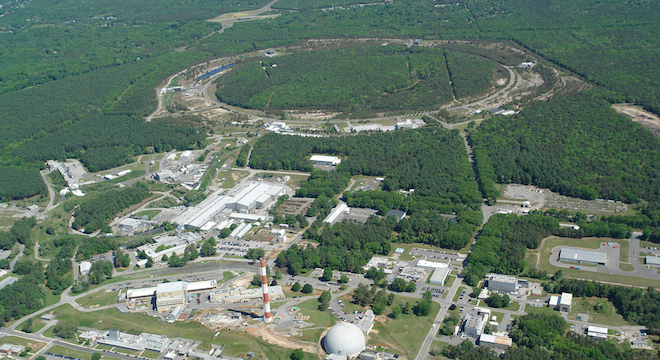It’s hot out there, but not as hot as it could be. Indeed, few things are any match for the recently announced Guinness World Record for hottest temperature ever achieved by humankind: An unfathomably scorching 7.2 trillion degrees fahrenheit (4 trillion degrees celsius), attained by a particle accelerator on Long Island in New York.
That temperature is nearly 250,000 times hotter than the center of the Sun.
The Relativistic Heavy Ion Collider (RHIC), located at Brookhaven National Laboratory in Upton, New York, is the machine responsible for producing the blistering heat, which scientists achieved by smashing ions of pure gold into each other at close to the speed of light in an effort to replicate the conditions of the universe “a millionth of a second after the Big Bang,” according to a Brookhaven news release published Monday about the record.
Check out a video simulation of the types of collisions that set the record:
But although the record-setting temperature was just publicized, the RHIC actually probably initially hit the milestone one summer 11 years ago.
“RHIC first collided gold ions at its full energy capacity in July 2001,” wrote Brookhaven physicist Paul Sorensen in an email to TPM. “That would be the first time that record setting temperature was ever achieved. The later dates reflect the long process that was required to actually ascertain what the temperature was. For that reason, the date when an analysis finally was able to determine the temperature can be somewhat ambiguous.”
“We have actually been producing such high temperature events for the past decade at RHIC,” added nuclear physicist Gene Van Buren, also via email.
In fact, even though the official record was hit back in 2001, there’s a high probability that 2.4-mile underground ring that makes up the RHIC produced an even hotter temperature by a few degrees in April of this year by colliding heavier uranium nuclei (the centers of uranium atoms).
“Uranium nuclei are shaped like American footballs so when they collide tip-on-tip, they can create an energy density that is larger than with gold collisions,” explained Sorensen. “It will take some time however to actually ascertain what the temperature was for those Uranium collisions.”
But even then, RHIC’s record is unlikely to last for very long.
As Sorensen noted and Brookhaven openly acknowledges, the temperatures achieved by particle collisions in another, larger and more powerful particle accelerator, the 17-mile-around Large Hadron Collider, located near Geneva, Switzerland, have also likely already eclipsed the 2001 RHIC record.
The Large Hadron Collider, which is on the hunt for the missing “God Particle,” the Higgs boson, collides particles at an energy density three times that of Brookhaven’s RHIC.
“If we wanted to get an even higher temperature, we would need a bigger accelerator like the LHC,” Sorensen told TPM.






